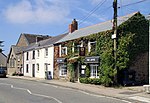Penhale Sands

Penhale Sands (Cornish: Peran Treth, meaning St Piran's sands), or Penhale Dunes, is a complex of sand dunes and a protected area for its wildlife, on the north Cornwall coast in England, UK. It is the most extensive system of sand dunes in Cornwall and is believed to be the landing site of Saint Piran. Dating from the 6th century, St Piran's Oratory is thought to be one of the oldest Christian sites in Britain. The remains were discovered in the late 18th century, and in 2014 the covering sand was removed to reveal a building more than a thousand years old, in a reasonable state of preservation. A restricted military area dating from 1939, Penhale Camp, is found on the northern part of the dunes. The area has been designated as a Site of Special Scientific Interest (SSSI) since 1953 and became a Special Area of Conservation (SAC) in 2004. The South West Coast Path runs through the dunes.
Excerpt from the Wikipedia article Penhale Sands (License: CC BY-SA 3.0, Authors, Images).Penhale Sands
Geographical coordinates (GPS) Address Nearby Places Show on map
Geographical coordinates (GPS)
| Latitude | Longitude |
|---|---|
| N 50.3728 ° | E -5.1353 ° |
Address
Perranzabuloe
England, United Kingdom
Open on Google Maps








